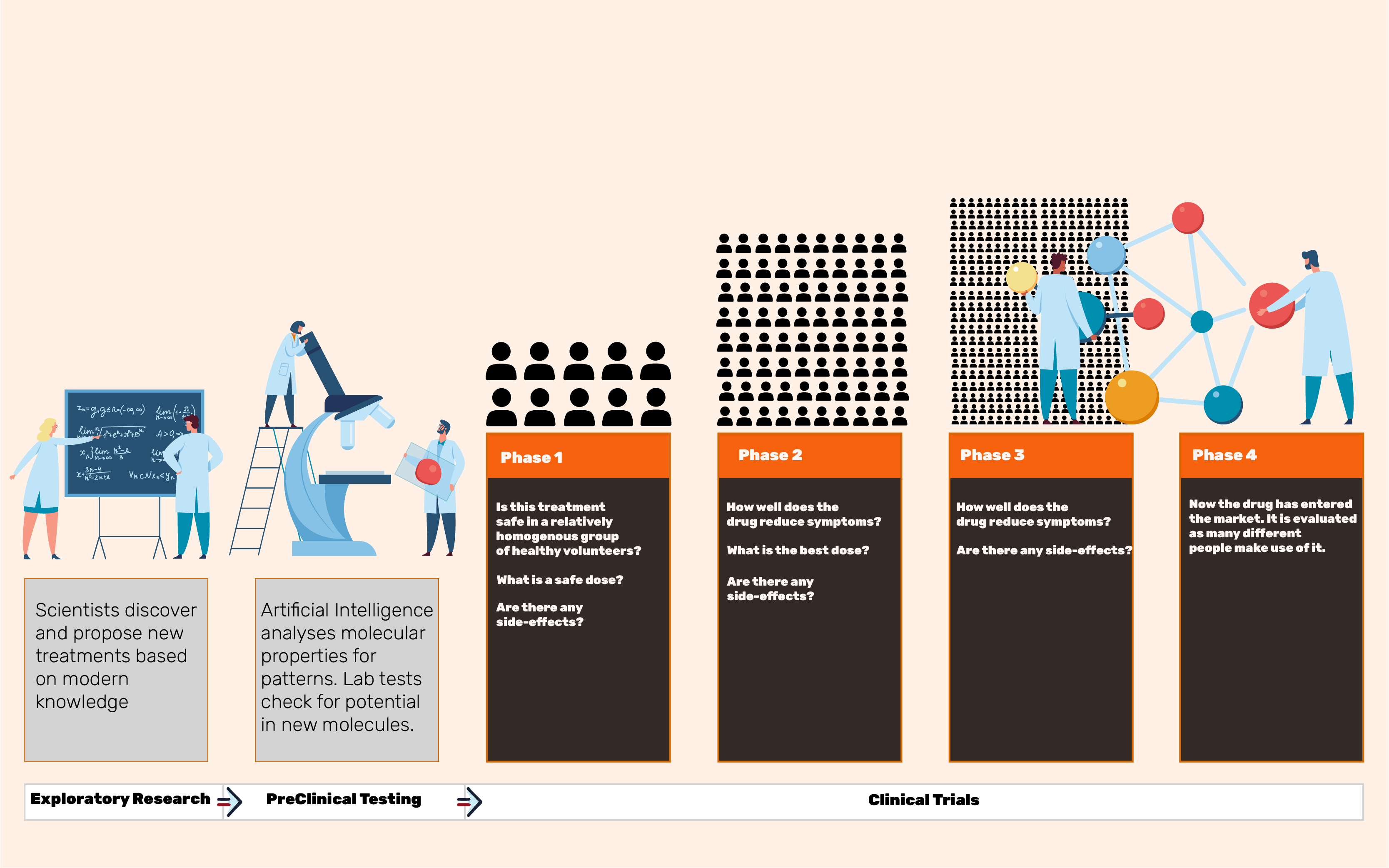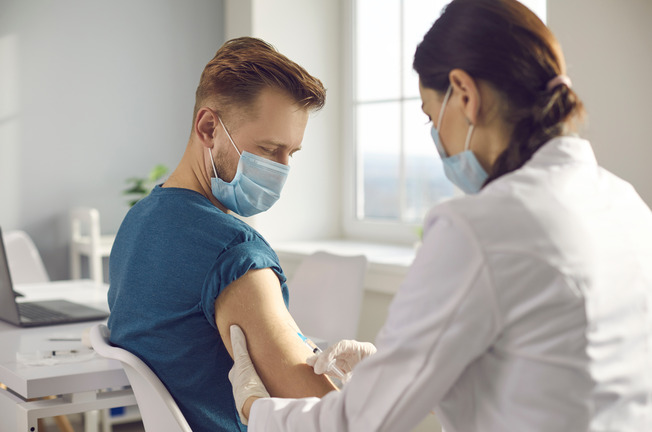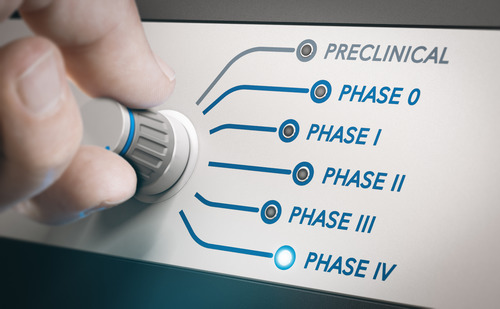A clinical trial is a planned experiment to understand the effectiveness and safety of a new treatment. Trials are regulated heavily for ethical standards, scientific precision, and the safety of volunteers.
Treatments can come in the form of medical procedures, drugs, devices, or behavioral changes.
When doctors and researchers think of a new way to treat disease, they must first prove that it is effective enough at reducing symptoms, and safe enough for many people to use. A clinical trial tests this using human volunteers.

Introduction to Clinical Trials
Clinical research is an extremely important field in relieving the symptoms of billions of people globally who have disease and illness. It is responsible for the innovative medical procedures that help us treat cancer, diabetes, and countless other medical conditions. Every household medicine that you can purchase first had to be tested and approved before the government allowed its sale. The findings of clinical trials also consistently contribute to greater understanding of disease, which leads us closer to curing them.
From a bird’s eye view, clinical trials are the path to a world where no one has to suffer from diseases. Where everybody is free to live their life without the burden of life-altering symptoms and incredible discomfort. It is arguably one of the most important industries in the modern world, and has potential to contribute remarkable change into our world.

Before testing on humans, scientists perform laboratory experiments to see if the proposed treatment has potential. Doctors will use artificial intelligence (A.I.) to examine molecules, and other scientific data. The use of A.I. in preclinical research is a rapidly evolving field that allows scientists to determine if a potential molecule has the potential to be effective or safe.
Once the simulation work is completed, scientists proceed to animal testing. In this stage doctors assess the medication’s safety and effectiveness. Animal testing is important to reveal drug toxicity, and side effects that might occur on humans.
As with every step of the clinical trial practice, scientists are required to follow strict rules on laboratory practice, data collection, and reporting. Scientists consider the demographics and other situational demands of the people who would be taking the theoretical drug and look to find any possible interactions that might make the drug dangerous.
When researchers are ready to move into phase 1 of clinical trials, they must submit an Investigational New Drug (IND) application. The IND application defines the plan for investigation, the study protocols, chemistry, manufacturing, and control data, pharmacology data, as well as any human experience data and other relevant information.


This is where clinical researchers start to test on humans, usually with a participant pool of 20-100 people. What they are looking to find out is how much of a dose to give, and what side effects occur.
Phase I trials aim to establish the safety and dosage range of a new drug in healthy volunteers, typically involving frequent blood draws to assess pharmacokinetics. Pharmacokinetics is how a drug is absorbed, distributed, metabolized, and excreted by the body over time.
These trials determine the maximum tolerated dose without significant side effects. While they carry risks, these trials are typically conducted on a small, healthy set of subjects to reduce the likelihood of harm. Volunteers are compensated for their participation, and around 70% of drugs progress beyond this phase.
Once the drug has been shown to be safe enough to continue testing it can proceed to phase 2.


In phase 2 of clinical trials the primary focus is dosage, safety, and effectiveness. Scientists are attempting to determine the best dose to combat disease through trial and error. The drug is also being evaluated for its efficacy, so, “does the drug work well?” If it works well enough it may progress to phase 3, but only if it proves to be safe as well.
Most phase 2 trials are randomized. Meaning neither doctor or patient know if they are receiving the actual drug or a placebo. Using a placebo is necessary because patients can “feel better” just because they believe they’ve taken medicine. This powerful mental illusion can cause patients to report optimistic or unrealistic results which ruins the scientific integrity of the study.
In this phase, researchers expand the pool of test subjects to around 100-500 participants. By testing on more subjects, scientists can search for rare side effects and events. Knowing about how the drug interacts with a larger population helps develop confidence in its safety.
Sometimes phase 2 trials are divided into phase 2a and phase 2b. Phase 2a focuses on determining dosage, while phase 2b focuses more on the efficacy of the drug.


It can take four to five years to reach phase 3 trials.
This part of the study consists of a large and diverse pool of participants. The pool of subjects in phase three is between 500-2000 participants, to be certain that it is safe. Treatments work differently for people depending on gender, age, race, sex, and ethnicity. Due to the need to test on so many people Phase 3 is often conducted across multiple research sites. This way researchers can test different demographics and health situations to understand more broadly the safety of the investigational drug. Investigational is clinical trial lingo for “currently being investigated”.
If everything goes well in this phase, and the drug is proven to be better than the alternative, the developer will apply for regulatory approval.

After the drug is approved by regulators such as the Food and Drug Administration (F.D.A) in the United States or Health Canada, doctors can begin prescribing it to patients. Although it may now be prescribed, the research doesn’t stop there. In previous phases, the doctors administer the drug, but now, the patient can go and see a pharmacist to pick it up for themselves.
Now that the drug is being distributed across the population, the fourth phase of research begins. The drug is closely monitored for safety as it is released into the market. All of this testing is thorough and takes many years, but it’s the only way to verify if releasing a medication is a good idea.
Much of the knowledge we gain on new drugs is actually acquired after its release. Due to the economics of running a clinical trial, a limited number of patients can test the drug. Against a seemingly endless combination of individual scenarios, it is impossible to foresee all outcomes. Also, further testing is often conducted by interested scientists and doctors after the drug is made commercially available.

Study Design
All serious research projects, from the field of business to medical research, use rigorous planning and strategy. This ensures the correct questions are asked and that the correct answers are gained. Trial design is important to maintain the scientific integrity of the research. It is also important to ensure the greatest efficiency of resources since research takes so long and costs so much money.

Basic Clinical Trial Design
A controlled trial usually uses a placebo to ensure that results identify who has truly benefited from the medication, and who has not. In some cases trials will simply use more medication per group of volunteers (formally known as an “arm”of volunteers). In another trial, scientists may use the new drug, and compare it to the old drug. There are many options for how to run a clinical trial but only one best way to answer a research question.
Researchers plan out the research question, and then determine the most effective and efficient way to achieve an answer that is statistically very likely to be correct.
Ethics in Clinical Trials
The role of clinical trials is to obtain scientific understanding of disease and treatments. None of this can be accomplished without the brave people who participate in them. Because humans are involved, and there is a potential for harm, ethics is one of the most important topics in the field of clinical research. Following ethical principles protects both the volunteers, and the scientific integrity of any discovery.
The United States National Institute of Health references several important guideline documents on ethics in clinical research:
- Nuremberg Code (1947)
- Declaration of Helsinki (2000)
- Belmont Report (1979)
- CIOMS (2002)
- U.S. Common Rule (1991)
These codes lay out rules such as informed consent, and limit the harm that can be caused to volunteers in trials. Much of these codes is a response to past violations, in particular by the Nazis during World War two.
The general idea is that patients should be protected, reasonably safe from harm, and capable of withdrawing at any time. Patients should also be fully informed of what risks the trial entails. Trials must be run with adequate preparation and planning so that the research answers a question which is expected to benefit society. Government regulations have become tighter since the first rules for clinical research were published, providing a safer and more rule-based clinical trial process.
Regulatory Oversight of Clinical Trials
In Canada clinical research is overseen by Health Canada. Health Canada conducts inspections to ensure that clinical trials are following all ethical and legal standards in recruitment, and trial practices. Before a clinical trial can begin, it must apply for, and receive the approval of Health Canada.
There are also many internal review boards (IRBs) that examine the administration of clinical trials. All of our patient facing material must first be approved by the sponsor of the drug, and secondly by an IRB to ensure adherence to legal requirements.
In the United States clinical research oversight is provided by the Food and Drug Administration (FDA).
Why do people participate in clinical trials?
- Helping researchers develop better treatments for everyone.
- Contributing to medical understanding of diseases for future generations.
- Potential to gain access to treatments that could relieve symptoms.
Are there risks associated with clinical trials?
Yes there are some risks. This is why there are stringent ethical and scientific codes and guidelines that govern every step of the clinical trial process. Any medication or intervention that’s in a clinical trial is being tested for its safety and effectiveness. Usually by phase 2, it’s been tested on 20-100 people, and has been determined to have a low likelihood of being dangerous.
However, the medication may cause uncomfortable side effects, and in some cases they may be serious. There is a risk that the medication might simply not work for you or that previous medications could be better. You could also be selected to be part of the placebo group and no one would know; and if this is the case you might consider the trial a waste of time. These are the risks necessary to changing the future of medical treatment, and they are considered very carefully by researchers, regulators, and administrators at every step of the way.
But, your contribution to research can help future generations to have better options, potentially even cures, for severe diseases. Diseases like psoriasis and hidradenitis supperativa can cause extreme discomfort, pain, and social distress. It’s not just an itch, and it’s not a small portion of the population either. Clinical researchers are coming closer to understanding the root causes of these diseases, and they are proposing innovative new interventions surprisingly frequently. No one could blame you if you missed the memo! Science is moving faster than ever!
What does Simcoderm Clinical Trials do?
Simcoderm Clinical Trials works on creating new treatments for skin conditions through the development of scientific knowledge. We are often chosen to be the first to test new treatments in Canada and at times the world. Our dermatologists have extensive expertise in treating and researching skin conditions, and our management of operations is at the highest level of skill and care.
We only run phase 2 and 3 clinical trials.
Trials start with a screening period where we check on the health of our volunteers to make sure there is a reasonable level of safety in letting them in the trial.
Next is the treatment period where we administer the drug and monitor its concentration in the body through scheduled blood tests.. Here we watch for side effects and evaluate the effectiveness of the drug for the patient’s symptoms.
All trials end with a follow up period where we check on your health and collect further information about your experience.
It is our hope and belief that through research we can find far more effective treatments for skin conditions that will contribute to the improvement of the lives of many people. There are several promising drugs in testing right now that we are helping to develop.
If you want to participate in any of our clinical trials click here or call us at 647-202-6393.
References
https://www.fda.gov/patients/drug-development-process/step-2-preclinical-research
https://www.news-medical.net/life-sciences/What-is-Preclinical-Testing.aspx
https://bmcneurol.biomedcentral.com/articles/10.1186/1471-2377-9-S1-S2/tables/2
https://med.uc.edu/depart/psychiatry/research/clinical-research/crm/trial-phases-1-2-3-defined
https://www.news-medical.net/health/What-is-a-Phase-2-Clinical-Trial.aspx
https://www.ncbi.nlm.nih.gov/pmc/articles/PMC6434767/
https://school.wakehealth.edu/education-and-training/graduate-programs/clinical-research-management-ms/features/ethics-in-clinical-research#:~:text=Core%20Principles&text=Verifying%20the%20scientific%20validity%20of,before%20they%20offer%20their%20consent
https://clinicalcenter.nih.gov/recruit/ethics.html
SimcoDerm is a full service, comprehensive dermatology clinic located in Barrie. We provide our services to all the patients in Simcoe County and beyond.
- 105-5 Quarry Ridge Rd. Barrie, On, L4M 7G1
- Tel: (705) 503-6333
© 2024 SimcoDerm

